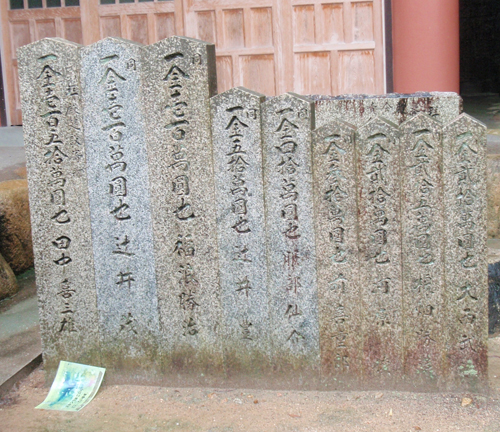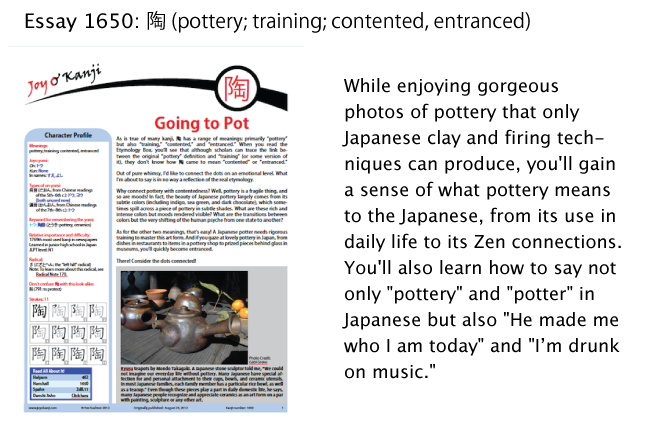One Singular Sensation
While we fuss and fret over thousands of kanji, we take a few simple ones for granted, particularly 一 (one). It's perfectly pictographic, so much so that there's nothing to grab ahold of there. And yet this kanji trips me up in unexpected ways.
Take, for example, the following sign:

Photo Credit: Eve Kushner
Monument at a shrine in Arima (Hyogo Prefecture), indicating the names of donors and the amounts of the donations.
My eye skipped right over the 一 at the top of each stone, treating those lines as decorative borders! But in fact they indicate that a new column has started (as if we couldn't already tell!). When itemizing things, the Japanese often start with 一.
Now consider this fragment, which came to me in an email:
一層パワーが増す
How many instances of 一 do you see here? Two? Actually, there's just one, in the beginning. Its doppelganger is a katakana dash that lengthens ワ. (The dash is a hair shorter than its look-alike kanji, though this is imperceptible until you massively increase the point size.)
I love how the similar shapes divide the phrase visually, almost turning the two halves into mirror images. I'm referring to not only 一 and ー but also the kanji sharing the 曽 component.
Actually, let's digress for a moment. What's going on with these look-alikes? Let's see.... Henshall says the following:
• In 層 (921: stratum, layer), the 曽 means "to build up."
• In 増 (741: to increase, build up), the 曽 again means "to build up."
What's more, we find an on-echo common to 層 (ソウ), 増 (ゾウ), and 曽 (ソ, ソウ, ゾウ). There's so much concealed in the short phrase 一層パワーが増す, giving it haiku-like power, at least from a kanji perspective.
You may be curious about what this phrase means. Well, 一層 (いっそう) is "much more; more than ever." And パワー is "power." So 一層パワーが増す translates as "will be even more powerful." How appropriate for our discussion!
Now, why does 一層 (いっそう: 1 + stratum, layer) mean "much more; more than ever"? That is, what does 一 contribute here? My proofreader says that, to him, 一層 has the sense of "one more on top of the great amount that's already there." In a good way, then, 一層 adds fuel to the fire.
Recently, 一 confused me in another way. I had given an Osaka-based man a Joy o' Kanji subscription because he was such a wonderful host last month, showering my husband and me with gifts. Here's what he wrote in reply:
早速一文字についての内容を隅々拝見させていただきました。
早速 (さっそく: at once); 内容 (ないよう: subject, contents); 隅々(すみずみ: nooks, corners); 拝見 (はいけん: to look at, stated in humble or polite language)
I loved his use of 隅々, which has a wonderful internal rhyme. I imagined that he had poked into every nook and cranny of the site. But Japanese friends have told me that the word doesn't actually carry much weight in the sentence.
So how do you translate his comment? And what about the word I've reddened? Here are its various yomi and definitions:
一文字
いちもんじ: straight line; beeline
ひともじ or いちもじ: (1) one character; (2) Welsh onion
I think we can safely toss out the onion. (What's it even doing in there?!) But which yomi and meaning apply? Both "beeline" and "one character" seem relevant; 早速 tells us that he perused the site immediately, and it makes perfect sense if he read about one character at a time, because that's how we do it here.
I turned to a proofreader, who went with いちもじ (one character). He would translate the sentence as "I immediately read (an essay) about one character," though he said I should ask my correspondent to verify this. (That seems like a very confusing conversation to have!)
The proofreader also explained why 一文字 could mean "beeline"; it can refer to a path "as straight as the kanji 一." Aha! He noted that one can say this in a more exaggerated way with 真一文字 (まいちもんじ), which means "truly as straight as the kanji 一."
For the first time, I pondered the term "beeline." It makes me think that bees always fly in a straight line, whereas other insects (e.g., butterflies) meander. I know little about insects, so I checked. Yes, the dictionary says that "beeline" comes from the "supposed homing instincts of bees in the field." Someone on Yahoo! Answers explained the etymology in a more colorful way, including some information about a "Waggle Dance" that bees do!
Here's my favorite 一 word at the moment, as I'm fresh from writing essay 2098 on 斑 (spot):
一斑 (いっぱん: a spot (glimpse, outline); sighting)
In ancient China, 一斑 meant "one leopard spot." The Chinese used a phrase back then that the Japanese rendered as follows:
一斑を見て全豹を卜す
to predict the whole leopard by glimpsing just one spot
見る (みる: to see); 全豹 (ぜんぴょう: whole leopard);
卜す (ぼくす: to divine)
That sounds like a very hard thing to extrapolate, but what a useful skill to have, particularly in the business world. Imagine having just one piece of data and using it to envision your whole market, your sales figures, and everything else you needed to know in order to thrive! This talent would also help with kanji. What if mastering 一 meant that you automatically understood thousands of other characters? Well, I'd be out of a job, but aside from that it sounds great!
I'm pleased to be able to present a new essay this week. It's on 陶 (pottery), and I learned a tremendous amount from working on it, including these historical nuggets:
1. Nearly a millennium ago, Japan developed a pottery industry because Zen masters wanted to popularize tea. They thought it would help if people could drink it out of appealing cups.
2. Three Zen masters were largely responsible for making tea a central part of Japanese life. In 1214, one wrote a tract on the health benefits of drinking tea. His goal: to save a shogun from alcoholism by giving him a substitute beverage!
Here's a preview of essay 1650:

Have ONE great weekend!

Comments